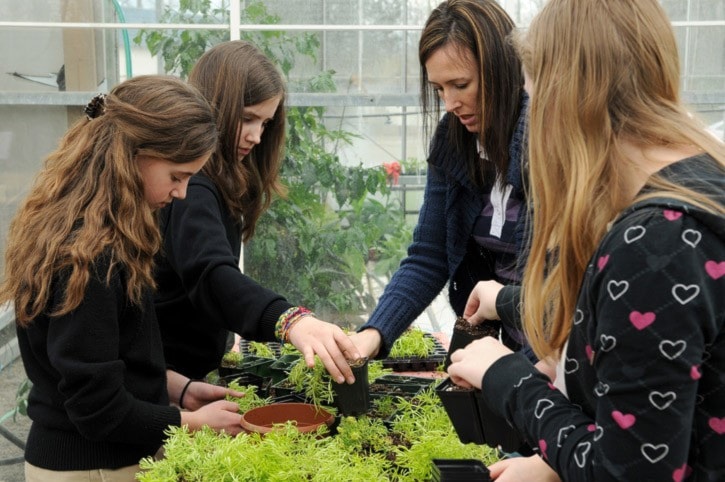With layers of dirt crusting under her fingernails, 13-year-old Robyn Page was in her element.
While other girls her age might turn their noses up at the mere sight of dirt, and are often more concerned with painting their nails, and chasing boys, than growing plants and vegetables, not Page.
“The greens are really fun to be around,” she said, as she transplanted a lobellia tropical bedding plant into a larger pot.
“When you’re all cooped up inside a classroom, it can get kind of boring. But out here, you’re more free, it’s hands on, and it’s cool to know each plant is a living organism and by helping it grow we’re helping build the environment.”
Page is a Grade 7 student at Highroad Academy; one of approximately 15 other students from Grades 7 to 12 participating in the school’s horticulture club.
On May 7, Highroad Academy is partnering with Sardis secondary for the school’s annual Mother’s Day Plant Sale. Sardis is taking care of the plants; Highroad the herbs and veggies.
The horticulture club was started two years ago by science teachers John Munro and Michelle Johnsrude who wanted to increase student interest in science.
Shortly after reading about Sardis secondary’s transformation of their horticulture and agriculture program through community partnerships, including a partnership with the University of the Fraser Valley, Munro wanted Highroad to have what Sardis had. But unlike Sardis, Highroad did not have access to a greenhouse.
Tom Baumann, head of the agriculture department at UFV, offered Highroad the use of UFV’s greenhouses, as well as his and professor Brent Bailey’s expertise.
“Our reasons [for helping] are quite obvious,” said Baumann. “We love what we do here, and we want to catch the kids early so they’ll love it and come into our program.”
Every Monday, students in the club spend an hour and a half planting, fertilizing, weeding, watering, pruning, grafting, transplanting. Pretty much anything to do with greenhouse growing, they’re doing. And they’re doing it during their own time after school.
Some kids may see it as work, but Grade 11 student Ina Van Eysinga said it was more like a hobby than work.
“I don’t really feel like I’m giving up my free time,” she said. “I like how it’s really freestyle learning, we’re not just following a set curriculum. And I like seeing new plants that I might not have ever seen like birds of paradise,” a tropical plant bearing a unique flower that resembles a colourful bird in flight.
This year the students produced more than 200 plants, herbs and vegetables, including basil, thyme, cilantro, oregano, parsley, pomello, chives, tomatoes, cucumbers, peppers, purple fountain grass, sedum and more.
“When we first started, I think some of the kids didn’t really believe that in eight to 12 weeks, these dried up, brown seeds would actually grow into something they could eat,” said Johnsrude. “But when they saw it growing and saw that they didn’t kill it, they were really excited.”
Grade 10 student Kushal Khera was impressed with the “way better” taste of Highroad’s tomatoes versus store-bought tomatoes.
“It was neat to see how the tastes were affected through the different growth mediums,” said Khera. “I think it’s really good to know where our food comes from.”
Being in the greenhouse “is different from science class where all we’re doing is researching and reading, but never actually doing anything with that,” said Khera. “Here, we’re actually doing stuff.”
And it’s comments like these that get the teachers excited.
Munro and Johnsrude dream of one day having a greenhouse of their own at Highroad Academy, as well as a full-credit agriculture course in place.
“I knew this was a good fit for our school,” said Munro. “It’s been a really good way of bolstering our science program.”
“And how cool is it to have 13-year-olds excited about their vegetables?” added Johnsrude.
•The Mother’s Day Plant Sale is at the Sardis secondary greenhouse, located just outside the school, on May 7 from 7 a.m. to 2 p.m. Up for grabs are hanging baskets, planters, cedar wishing wells, a variety of annuals, herbs and vegetables – all student grown.
kbartel@theprogress.com
